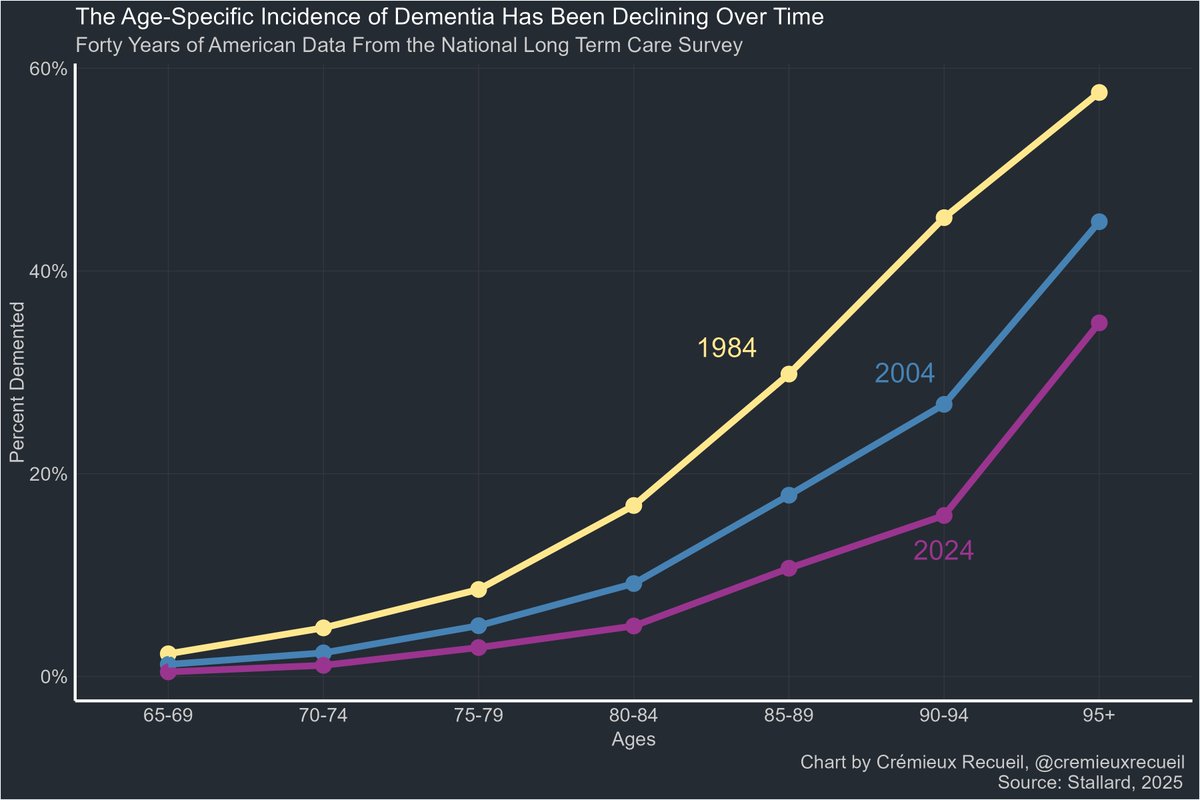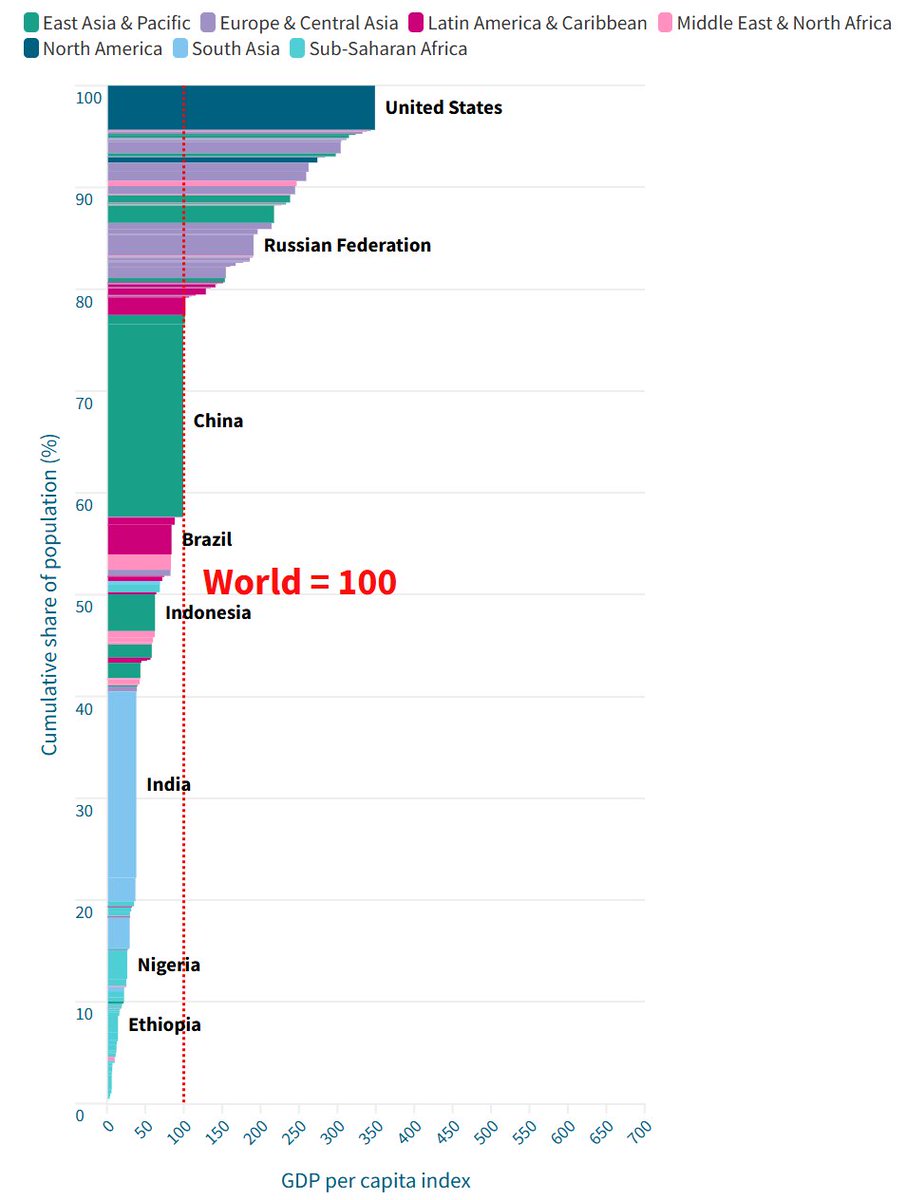Timeline's feeling down. Thread of good news.
At every age, the incidence of dementia is down. As a society, people are no longer suffering dementia nearly as often!
At every age, the incidence of dementia is down. As a society, people are no longer suffering dementia nearly as often!

The world over, child mortality is way down. It's unusual for parents to experience the death of a child these days, where even a century ago, it was the global norm. 

Each year, novel gene therapies are approved.
The number of gene therapies in the pipeline is also rapidly increasing. There is tons of progress to be made here, and the main issue is regulatory.
We have lots of low-hanging fruit in curing disease!
The number of gene therapies in the pipeline is also rapidly increasing. There is tons of progress to be made here, and the main issue is regulatory.
We have lots of low-hanging fruit in curing disease!

Global tree cover has increased in recent years with the greening and reforestation of the globe.
This trend holds on almost every continent!
This trend holds on almost every continent!

Globally, fewer and fewer people are dying from natural disasters.
The rates of natural disaster death nowadays are a small fraction of what they used to be.
The rates of natural disaster death nowadays are a small fraction of what they used to be.

Moore's Law has accurately described the evolution of the number of transistors per microprocessor, and even after this animation ends, it seems to have continued holding.
Though America's homicide recently skyrocketed in the days after George Floyd's death, the rate has since returned to normal and is back on track to keep falling. 

Mandatory enrichment of cereal grain products with folic acid led to a decline in the number of babies born with neural tube defects in the U.S. 

America's cancer death rates are up if you fail to acknowledge that the country has gotten older.
Once you acknowledge that people have gotten older, it becomes apparent that America's cancer death rates have substantially declined!
Once you acknowledge that people have gotten older, it becomes apparent that America's cancer death rates have substantially declined!

When countries run campaigns to teach parents how to position their babies when they sleep, the result is typically a considerable reduction in SIDS death rates in just a few years. 

It's true that people are getting fatter and fatter, but our medical system has kept up.
Despite rising obesity, cardiovascular disease is claiming fewer and fewer lives at each age.
Despite rising obesity, cardiovascular disease is claiming fewer and fewer lives at each age.

There's more good news out there.
Every day, diseases are cured and prevented, people are losing weight, babies are born healthier than they've ever been, people get richer and their lives become more manageable, and more.
Day-to-day, things may seem hard, but progress is real!
Every day, diseases are cured and prevented, people are losing weight, babies are born healthier than they've ever been, people get richer and their lives become more manageable, and more.
Day-to-day, things may seem hard, but progress is real!
Sources below.
Dementia:
Source: alzforum.org/news/research-… (Possible non-exciting explanation: More people are surviving to old age now, so maybe people who wouldn't have survived previously are disposed to lower dementia rates.)
Archive: archive.md/9RW41
Replication in Sweden: academic.oup.com/biomedgerontol…
Replication in England: sciencedirect.com/science/articl…
Related, supporting multi-country work: x.com/cremieuxrecuei…
Supportive German evidence: journals.sagepub.com/doi/full/10.11…
Evidence against this being due to education: journals.sagepub.com/doi/full/10.11…, psycnet.apa.org/doiLanding?doi…
Data showing that, despite falling age-specific incidence, prevalence is still up because the population is getting older: bmj.com/content/358/bm…, sciencedirect.com/science/articl…
Child mortality:
Source: ourworldindata.org/grapher/child-…
Gene therapy:
Source: healthadvances.com/insights/blog/…
Archive: archive.md/WDuVB
Tree cover:
Source: humanprogress.org/trends/more-la…
Archive: archive.md/gyMtj
Natural disaster deaths:
Source: humanprogress.org/trends/a-safer…
Archive: archive.md/XjTVK
Moore's Law:
Source: reddit.com/r/dataisbeauti…
Archive: archive.md/TIWyA
More: ourworldindata.org/data-insights/…
Homicide: See CDC WONDER and my previous posts on the Floyd Effect.
Neural tube defects:
Source: pmc.ncbi.nlm.nih.gov/articles/PMC45…
Age-standardized cancer death rates:
Source: ourworldindata.org/grapher/cancer…
More: blogs.cdc.gov/nchs/2021/09/1…
SIDS:
Source: direct.mit.edu/rest/article-a…
Cardiovascular disease:
Source: ourworldindata.org/data-insights/…
Dementia:
Source: alzforum.org/news/research-… (Possible non-exciting explanation: More people are surviving to old age now, so maybe people who wouldn't have survived previously are disposed to lower dementia rates.)
Archive: archive.md/9RW41
Replication in Sweden: academic.oup.com/biomedgerontol…
Replication in England: sciencedirect.com/science/articl…
Related, supporting multi-country work: x.com/cremieuxrecuei…
Supportive German evidence: journals.sagepub.com/doi/full/10.11…
Evidence against this being due to education: journals.sagepub.com/doi/full/10.11…, psycnet.apa.org/doiLanding?doi…
Data showing that, despite falling age-specific incidence, prevalence is still up because the population is getting older: bmj.com/content/358/bm…, sciencedirect.com/science/articl…
Child mortality:
Source: ourworldindata.org/grapher/child-…
Gene therapy:
Source: healthadvances.com/insights/blog/…
Archive: archive.md/WDuVB
Tree cover:
Source: humanprogress.org/trends/more-la…
Archive: archive.md/gyMtj
Natural disaster deaths:
Source: humanprogress.org/trends/a-safer…
Archive: archive.md/XjTVK
Moore's Law:
Source: reddit.com/r/dataisbeauti…
Archive: archive.md/TIWyA
More: ourworldindata.org/data-insights/…
Homicide: See CDC WONDER and my previous posts on the Floyd Effect.
Neural tube defects:
Source: pmc.ncbi.nlm.nih.gov/articles/PMC45…
Age-standardized cancer death rates:
Source: ourworldindata.org/grapher/cancer…
More: blogs.cdc.gov/nchs/2021/09/1…
SIDS:
Source: direct.mit.edu/rest/article-a…
Cardiovascular disease:
Source: ourworldindata.org/data-insights/…
• • •
Missing some Tweet in this thread? You can try to
force a refresh















